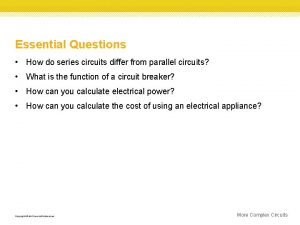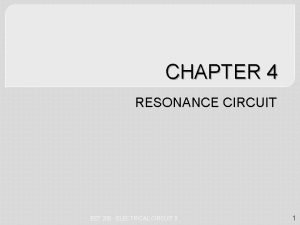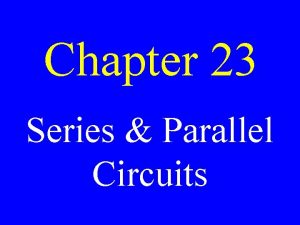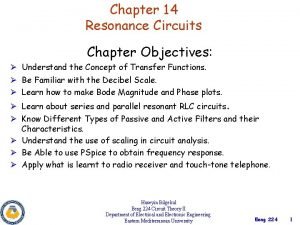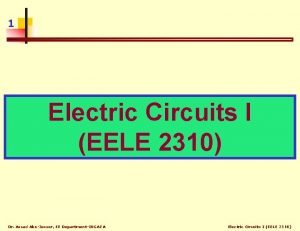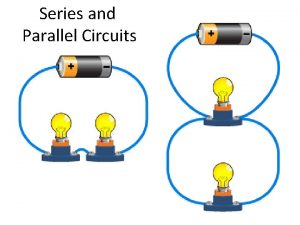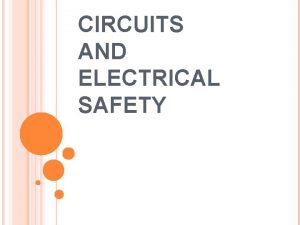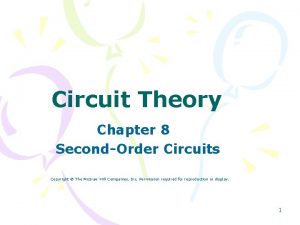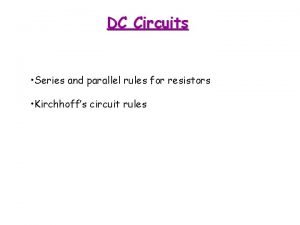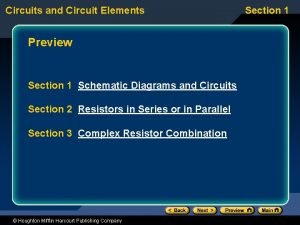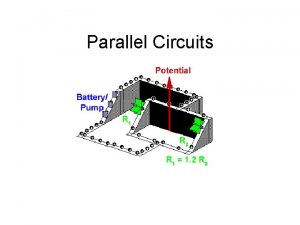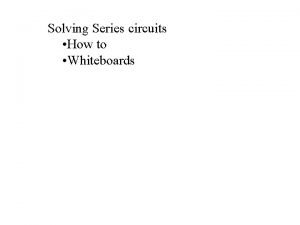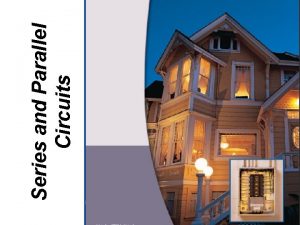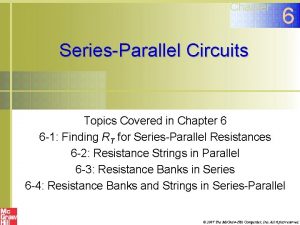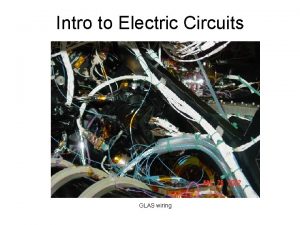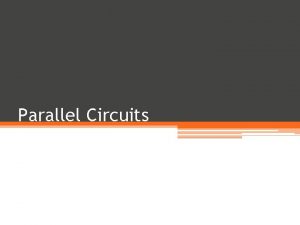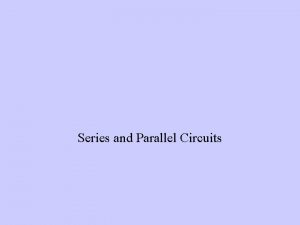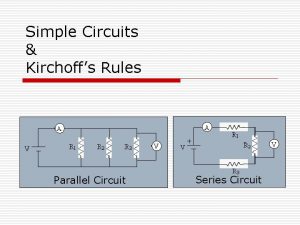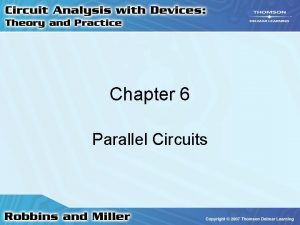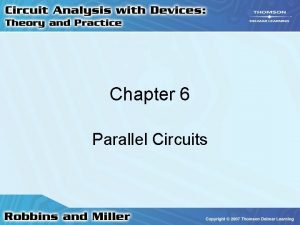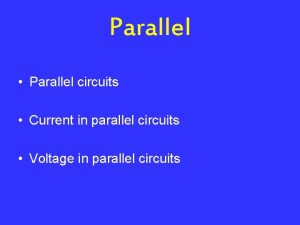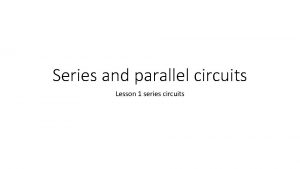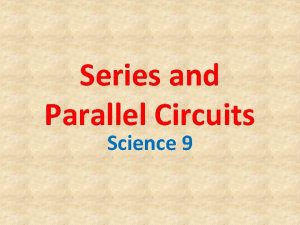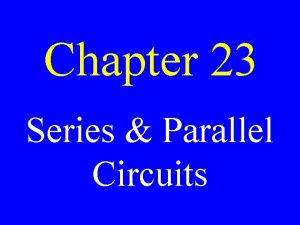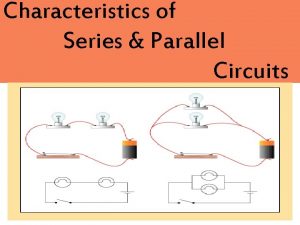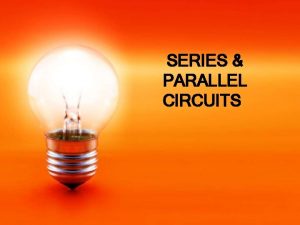Series and Parallel Circuits Series vs Parallel Circuit




























- Slides: 28

Series and Parallel Circuits

Series vs Parallel Circuit Series Circuit • Electrons only have one • There are MULTIPLE paths for the current to path to flow through.

Series Circuit The components are connected end-to-end, one after the other. They make a simple loop for the current to flow round.

Disadvantages of a Series Circuit + I –

Disadvantages of a Series Circuit + – I The more devices (resistors) in a series circuit, the less current passes through (dimmer bulbs).

Disadvantages of a Series Circuit + – I

Disadvantages of a Series Circuit + – If one resistor breaks (a bulb goes out) the entire series is turned off.

Series Circuit - Resistance • Total resistance goes UP with each resistor since the current has must go through each resistor. • Total Resistance = Sum of all resistors in the series Rtotal = R 1+R 2+ R 3…

Series Circuit - Current • Current = amount of charge (flow of electrons) – Like the flow of water • A current can't just disappear (appear) – Since only one path if some electrons flow through R 1, then they have to continue flowing through R 2 and R 3. – Since the Current is the same through the entire circuit IT=I 1=I 2=I 3

Series Circuit - Voltage • Voltage is the electric equivalent of water pressure. – The higher the voltage, the faster electrons will flow through the conductor. • Each component has resistance that causes a drop in voltage (reduction in voltage). • Total Voltage = The sum of voltages across each series resistors V T = V 1 + V 2 + V 3…

Series Circuit Measurement 90 V + 2 A – 2 A 50 V 10 V 30 V 2 A

I a series circuit configuration, the total resistance of the circuit is the sum of the resistance levels. 90 V + –

Series Circuit: Total Resistance 90 V + – 2 A 90 V

I a series circuit configuration, the total voltage of the circuit is the sum of the voltage levels. 90 V + 2 A – 2 A 50 V 10 V 30 V 2 A

Parallel Circuit The components are connected side-by-side.

Advantages of a Parallel Circuit + – The more devices (resistors) in a parallel circuit, does not decrease the current (does not dim bulbs).

Advantages of a Parallel Circuit + –

Advantages of a Parallel Circuit + – If one resistor breaks (a bulb goes out) the rest do not.

Parallel Circuit - Resistance • Resistors added side-by-side • The more paths, the less TOTAL resistance. 1/ Req=1/R 1+1/R 2+1/R 3 • Ex. 2 resistors in parallel with 4Ω each. • Since the circuit offers two equal pathways for charge flow, only 1/2 the charge will choose to pass through a given branch.

Parallel Circuit - Current • ALL paths are used! – The current is divides up into all branches – One branch can have more current than another branch (depends on resistance in branch). • Total current = sum of current in each path IT = I 1 + I 2 + …

Parallel Circuit - Voltage • A charge only passes through a single resistor. • Voltage drop across the resistor that it chooses to pass through must equal the voltage of the battery. • Total voltage = the voltage across each individual resistor VT = V 1 = V 2 = …

Disadvantages of a Parallel Circuit + – Adding additional resistance increase total current flow. More energy is required.

Disadvantages of a Parallel Circuit + – To protect the circuit from heat damage, a fuse maybe added to the circuit.

Disadvantages of a Parallel Circuit + – To protect the circuit from heat damage, a fuse maybe added to the circuit.

Series vs Parallel Chart Series Parallel Voltage (V) Vtot = V 1 + V 2 + V 3… Vtot = V 1 = V 2 = … Current (I) Itot=I 1=I 2=I 3 Itot = I 1 + I 2 + … Resistance (R) Req = R 1+R 2+ R 3… 1/Req=1/R 1+1/R 2+1/R 3

Series Circuit - Example • Given – Vbattery = 12 V – R 1 = 50 W, R 2 = 100 W, R 3 = 100 W • Complete the following table V = I R 1 2 3 -----------------------T

Parallel Circuit - Example • Given – Vbattery = 12 V – R 1 = 50 W, R 2 = 100 W, R 3 = 100 W • Complete the following table: V = I R 1 2 3 -----------------------T

END
 Series parallel circuit current
Series parallel circuit current Static vs current electricity venn diagram
Static vs current electricity venn diagram Parallel vs series
Parallel vs series Types of circuit
Types of circuit Capacitor series parallel
Capacitor series parallel Pros and cons of parallel and series circuits
Pros and cons of parallel and series circuits Difference between parallel and series connection
Difference between parallel and series connection For protection household circuits contain
For protection household circuits contain Series and parallel circuits
Series and parallel circuits Chapter 23 series and parallel circuits
Chapter 23 series and parallel circuits Series and parallel circuits
Series and parallel circuits Lesson 8: comparing series and parallel rlc circuits
Lesson 8: comparing series and parallel rlc circuits Facts about parallel circuits
Facts about parallel circuits Bill nye static electricity worksheet
Bill nye static electricity worksheet Venn diagram series and parallel circuits
Venn diagram series and parallel circuits V r and i in parallel circuits ch.8:1 answer key
V r and i in parallel circuits ch.8:1 answer key Series circuit rules
Series circuit rules Voltage in parallel circuit
Voltage in parallel circuit Draw a parallel circuit
Draw a parallel circuit Circuit construction kit
Circuit construction kit Circuits and circuit elements
Circuits and circuit elements Types of circuits
Types of circuits Solving series circuits
Solving series circuits Applications of series circuits
Applications of series circuits Applications of series circuits
Applications of series circuits Solving parallel circuits
Solving parallel circuits Parallel circuits
Parallel circuits What is incomplete circuit
What is incomplete circuit Circulatory system labeled
Circulatory system labeled







